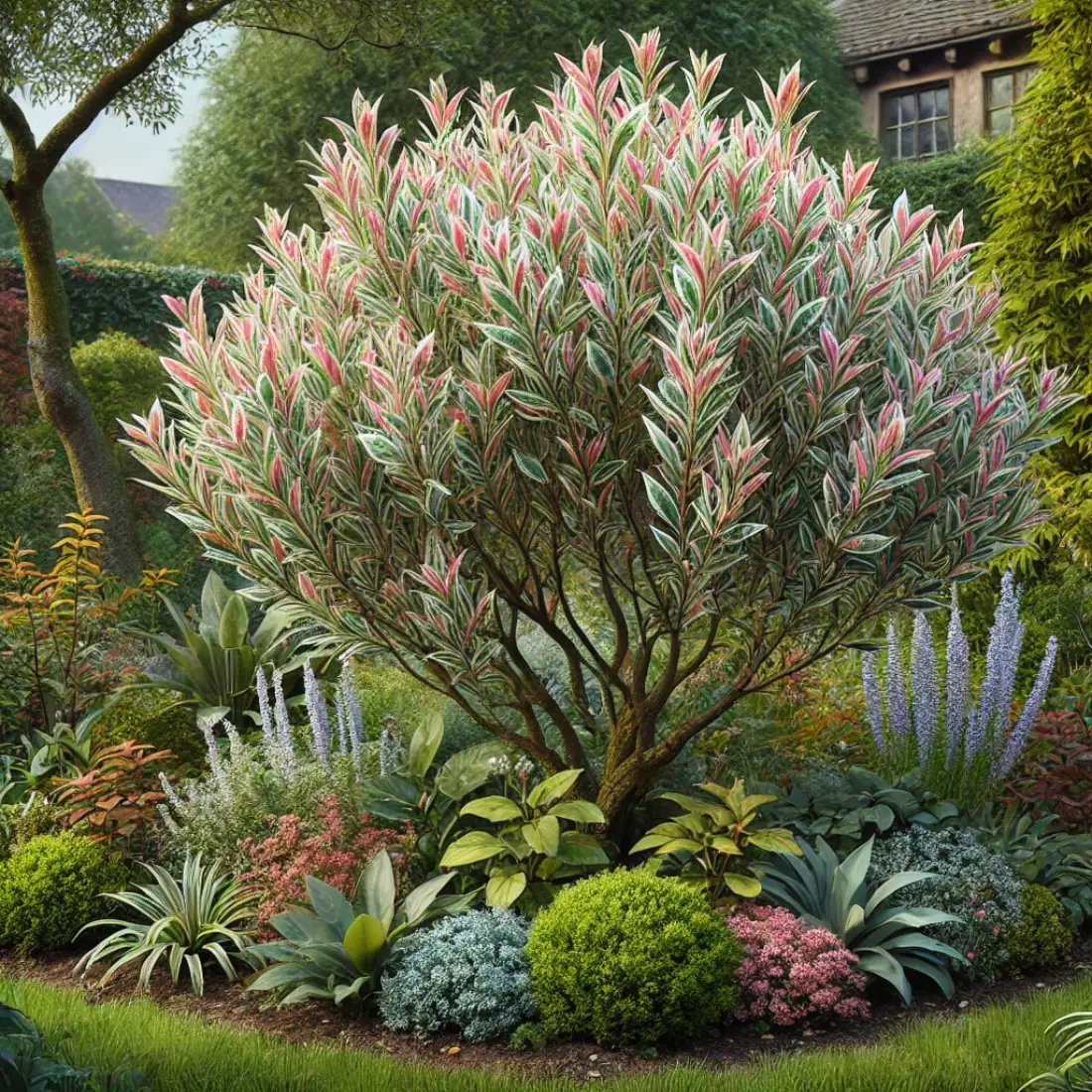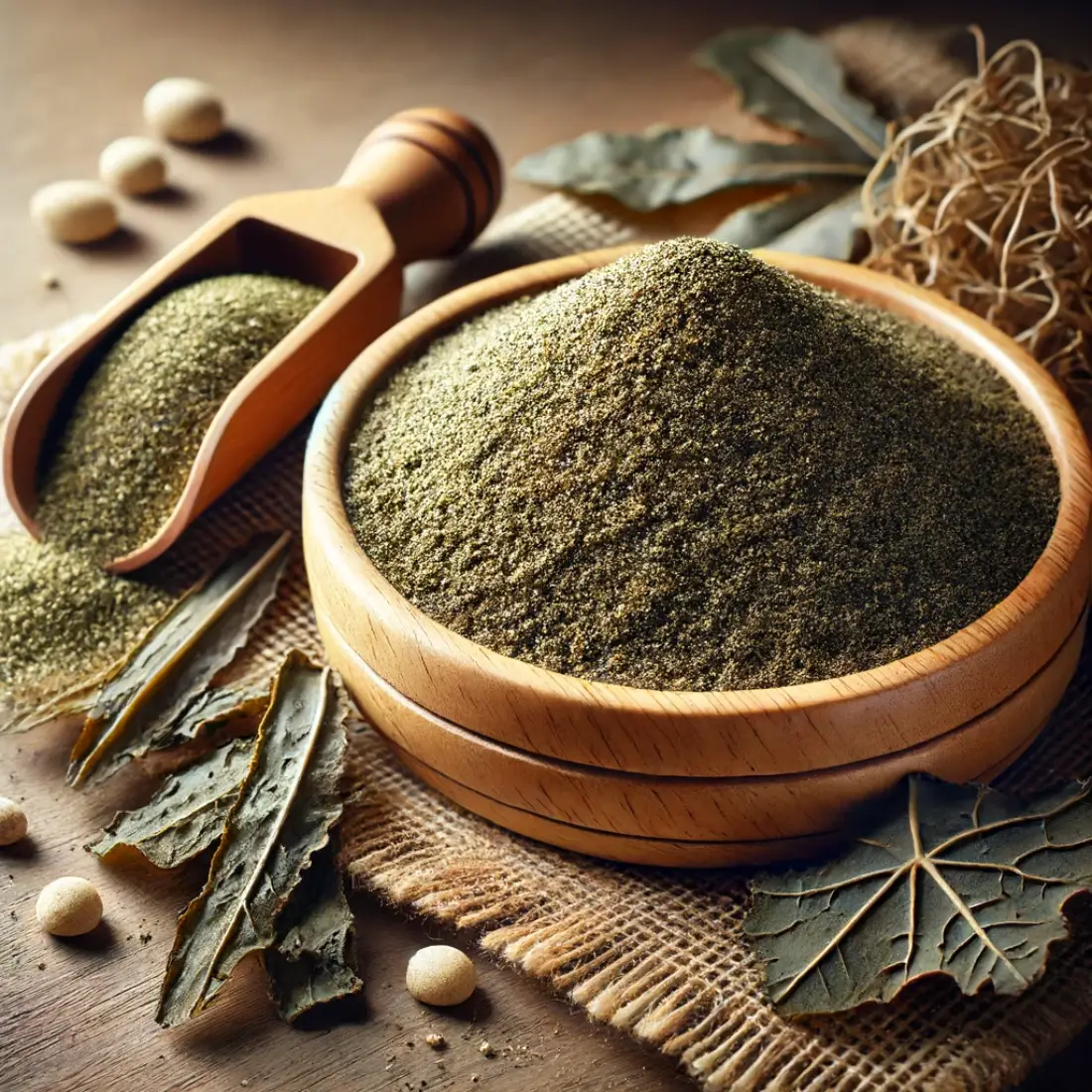The Variegated Dappled Willow, scientifically known as Salix integra, is a deciduous shrub renowned for its strikingly colorful foliage. Native to East Asia, this plant is especially popular in gardens and landscapes for its vibrant appearance and easy maintenance.
The foliage features a blend of pink, white, and green hues, creating a dappled effect that is particularly attractive during the growing season.
The Variegated Dappled Willow offers several benefits to gardeners and landscapers:
- Aesthetic Appeal: Its unique variegated leaves and graceful, arching branches add visual interest and beauty to any garden setting.
- Versatility: This shrub can be used in various landscape designs, including as a focal point, in borders, or as a privacy screen.
- Ease of Care: It is relatively low-maintenance, making it suitable for both novice and experienced gardeners.
- Wildlife Attraction: The plant provides habitat and food for various birds and beneficial insects, contributing to the biodiversity of your garden.
- Erosion Control: Its robust root system helps prevent soil erosion, making it an excellent choice for stabilizing slopes and riverbanks.
Common Varieties and Their Characteristics
Several varieties of Salix integra are popular among gardeners, each with distinct characteristics:
Salix integra ‘Hakuro Nishiki’: The most widely cultivated variety, known for its pink-tinged new growth that turns white and green as the leaves mature.
Salix integra ‘Flamingo’: Similar to ‘Hakuro Nishiki’ but with more pronounced pink coloring on the new leaves.
Salix integra ‘Pendula’: A weeping form of the dappled willow, offering a cascading effect that is ideal for ornamental purposes.
Planting
Choosing the Right Location
- Ideal Sunlight Conditions: The Variegated Dappled Willow thrives best in full sun to partial shade. It requires at least 4-6 hours of direct sunlight daily to maintain its vibrant foliage colors. In hotter climates, some afternoon shade can help prevent leaf scorch.
- Soil Requirements: This shrub prefers moist, well-drained soil. While it can tolerate a range of soil types, including clay, loam, and sandy soils, it performs best in soil that is rich in organic matter. The ideal pH range for the soil is slightly acidic to neutral (pH 5.5 to 7.0).
Planting Process
When to Plant:
- The best time to plant the Variegated Dappled Willow is in early spring or fall when the weather is cooler and the plant can establish roots before the onset of hot summer temperatures or winter frost.
Preparing the Soil:
- Clear the planting area of weeds and debris.
- Loosen the soil to a depth of about 12-15 inches.
- Amend the soil with compost or well-rotted manure to improve fertility and drainage if necessary.
Planting Depth and Spacing:
- Dig a hole that is twice as wide and just as deep as the root ball of the plant.
- Place the shrub in the hole so that the top of the root ball is level with or slightly above the ground surface.
- Backfill the hole with soil, gently firming it around the base of the plant to eliminate air pockets.
- Space multiple plants about 4-6 feet apart to allow for proper air circulation and growth.
Initial Watering and Mulching:
- Water the newly planted shrub thoroughly to settle the soil around the roots.
- Apply a 2-3 inch layer of mulch around the base of the plant, keeping it a few inches away from the stem to prevent rot. Mulching helps retain soil moisture, suppress weeds, and regulate soil temperature.
Watering
Frequency of Watering:
- During Establishment: Newly planted Variegated Dappled Willows need consistent moisture to establish their root systems. Water deeply once or twice a week, ensuring the soil is kept evenly moist but not waterlogged.
- Established Plants: Once established, these shrubs are moderately drought-tolerant but still prefer regular watering. Aim to water deeply every 7-10 days, depending on weather conditions. During hot, dry periods, increase the frequency to prevent stress and leaf scorch.
Signs of Overwatering and Underwatering:
- Overwatering: Symptoms include yellowing leaves, leaf drop, and root rot. Ensure the soil drains well and avoid waterlogging the plant.
- Underwatering: Symptoms include wilting, browning leaf edges, and leaf drop. Regularly check soil moisture levels and increase watering during dry spells.
Mulching
Benefits of Mulching:
- Moisture Retention: Mulch helps retain soil moisture by reducing evaporation, which is especially beneficial during dry periods.
- Weed Suppression: Mulch acts as a barrier to weeds, reducing competition for water and nutrients.
- Temperature Regulation: Mulch helps insulate the soil, keeping it cooler in the summer and warmer in the winter.
- Soil Health: As organic mulch breaks down, it adds valuable nutrients to the soil, improving its structure and fertility.
Recommended Mulch Types and Application Tips:
Types:
- Organic mulches such as shredded bark, wood chips, compost, or leaf mold are ideal. These materials decompose over time, enriching the soil.
Application:
- Apply a 2-3 inch layer of mulch around the base of the plant, extending out to the drip line (the area directly beneath the outermost branches).
- Keep the mulch a few inches away from the stem to prevent rot and pests.
- Replenish mulch annually or as needed to maintain the desired thickness.
Organic Fertilizing
To keep your Variegated Dappled Willow healthy and thriving, it’s important to provide it with the right nutrients through organic fertilization. Organic fertilizers not only nourish the plant but also improve soil structure and fertility over time.
Fertilizer Types
Organic fertilizers such as compost, manure, bone meal, fish emulsion, and seaweed extract are ideal for the Variegated Dappled Willow. Compost, rich in nutrients and beneficial microorganisms, enhances soil structure and fertility. Well-rotted manure (from cows, horses, or chickens) provides excellent nutrient content and organic matter.
Bone meal offers a slow-release source of phosphorus, which is crucial for root development. Fish emulsion, a balanced and fast-acting liquid fertilizer, supplies a variety of essential nutrients. Seaweed extract, rich in micronutrients and growth hormones, promotes overall plant health.
Application Schedule
For optimal growth, fertilize your Variegated Dappled Willow twice a year. In early spring, apply a balanced organic fertilizer to support new growth as the plant comes out of dormancy. A second application in mid-summer helps sustain growth and maintain foliage color throughout the growing season.
How to Apply Fertilizer
- Compost: Spread a 1-2 inch layer of compost around the base of the plant, extending to the drip line. Gently work it into the top few inches of soil, being careful not to disturb the roots.
- Manure: Apply a thin layer (1-2 inches) of well-rotted manure in the same manner as compost, ensuring it is well-integrated into the soil to avoid nitrogen burn.
- Bone Meal: Sprinkle bone meal lightly over the soil surface and mix it in around the root zone. Follow the package instructions for the appropriate amount based on plant size.
- Fish Emulsion and Seaweed Extract: Dilute these liquid fertilizers according to the manufacturer’s instructions. Apply them as a soil drench or foliar spray, ensuring even coverage of the root zone.
Tips for Effective Organic Fertilizing
Before applying fertilizers, conduct a soil test to determine nutrient deficiencies and pH levels, which helps tailor the fertilization plan to the specific needs of your plant. Use a combination of different organic fertilizers to provide a balanced supply of macro and micronutrients. Avoid over-fertilization, as too much fertilizer can harm the plant. Follow recommended application rates and avoid fertilizing late in the growing season, as this can promote tender growth susceptible to winter damage.
After applying fertilizers, water the plant thoroughly to help nutrients penetrate the soil and reach the root zone. Regularly monitor plant health and growth; if the plant shows signs of nutrient deficiencies, adjust your fertilization routine accordingly.
By using organic fertilizers and following these tips, you can promote healthy growth, vibrant foliage, and overall vigor in your Variegated Dappled Willow while also enhancing soil health and sustainability.
Pruning
Proper pruning is essential for maintaining the health, shape, and vigor of your Variegated Dappled Willow. Regular pruning encourages bushier growth, enhances the plant’s aesthetic appeal, and helps prevent disease.
Purpose of Pruning
Pruning your Variegated Dappled Willow serves several important purposes. It encourages bushier, more compact growth by stimulating the development of new shoots. Pruning also helps maintain the desired shape and size of the shrub, ensuring it fits well within your garden space.
Additionally, removing dead, damaged, or diseased branches improves the overall health of the plant and reduces the risk of pest infestations and disease.
Best Time to Prune
The ideal time to prune a Variegated Dappled Willow is in late winter to early spring, just before new growth begins. Pruning during this period allows you to shape the plant and remove any winter damage while minimizing stress on the plant.
Avoid pruning during the late summer or fall, as this can stimulate new growth that may not harden off before winter, making it susceptible to frost damage.
Pruning Techniques
Tools Needed: To prune your Variegated Dappled Willow, you’ll need a pair of sharp, clean pruning shears for smaller branches and loppers for larger branches. A pruning saw may be necessary for very thick branches.
Step-by-Step Pruning Instructions:
- Inspect the Plant: Before you begin, thoroughly inspect the plant to identify branches that need to be removed or trimmed. Look for dead, damaged, or diseased branches, as well as any crossing or rubbing branches.
- Remove Dead, Damaged, and Diseased Wood: Start by cutting away any dead, damaged, or diseased branches. Make clean cuts just above a healthy bud or branch junction to promote healing.
- Thin Out Overcrowded Branches: Thin out any overcrowded branches to improve air circulation and light penetration within the canopy. Remove branches that cross or rub against each other to prevent damage and disease.
- Shape the Plant: Shape the plant by selectively trimming back branches to maintain the desired size and form. Cut back long or wayward branches to a lateral bud or side branch that is growing in the direction you want.
- Encourage Bushier Growth: To encourage bushier growth, prune back the tips of branches. This stimulates the plant to produce new shoots and results in a denser, more compact shrub.
- Clean Up: After pruning, clean up all the cuttings and debris from around the plant to prevent disease and pests. Dispose of or compost the pruned material properly.
Propagation
Propagating the Variegated Dappled Willow allows you to create new plants from an existing one, expanding your garden or sharing with friends. The most common and effective methods for propagating this shrub are through cuttings and layering.
Methods of Propagation
Cuttings: This is the most popular method for propagating the Variegated Dappled Willow. Softwood cuttings taken in late spring or early summer tend to root more successfully.
Layering: This method involves bending a low branch to the ground and encouraging it to root while still attached to the parent plant. This technique can be done in late spring or early summer.
Propagating by Cuttings:
Selecting and Preparing Cuttings:
- Choose healthy, non-flowering shoots from the current year’s growth. The shoots should be about 6-8 inches long and have several sets of leaves.
- Using sharp, clean pruning shears, cut just below a node (the point where leaves attach to the stem).
- Remove the leaves from the lower half of the cutting to reduce moisture loss and focus the plant’s energy on root development.
- Dip the cut end of the cutting in rooting hormone to enhance root formation (optional but recommended).
Rooting Process:
- Fill a small pot or seed tray with a well-draining rooting medium, such as a mix of peat and perlite or sand.
- Insert the cuttings into the rooting medium, burying the lower nodes but keeping the upper leaves above the surface.
- Water the cuttings thoroughly and cover the pot or tray with a clear plastic bag or dome to create a humid environment. Ensure the plastic does not touch the leaves by using stakes or sticks for support.
- Place the pot or tray in a bright, indirect light location. Avoid direct sunlight, which can scorch the cuttings.
- Check the cuttings regularly to keep the rooting medium moist but not waterlogged. Mist the cuttings if necessary to maintain humidity.
- After 4-6 weeks, gently tug on the cuttings to check for root development. Once roots are established, gradually acclimate the new plants to outdoor conditions before transplanting them to their permanent location.
Propagating by Layering:
Selecting and Preparing a Branch:
- Choose a healthy, flexible branch that is close to the ground.
- Remove any leaves and side shoots from a 6-8 inch section of the branch where it will be buried.
Encouraging Root Development:
- Gently bend the branch to the ground and create a shallow trench where the prepared section will be buried.
- Wound the underside of the branch by making a small cut or scraping the bark to expose the cambium layer. This will encourage root formation.
- Secure the wounded section of the branch in the trench using a U-shaped pin or a small rock to hold it in place.
- Cover the wounded section with soil, leaving the growing tip of the branch exposed.
- Water the area thoroughly and keep the soil moist.
Aftercare and Transplanting:
- Check the layered branch regularly to ensure the soil remains moist.
- Roots should develop within a few months. Once the new roots are well established, cut the branch from the parent plant.
- Carefully dig up the new plant and transplant it to its permanent location, ensuring it receives proper care and watering.
Winter Care
Proper winter care is crucial for ensuring that your Variegated Dappled Willow remains healthy and vigorous through the cold months. While these shrubs are relatively hardy, taking a few precautionary steps can help protect them from winter damage.
Preparing for Winter
Reducing Watering:
As temperatures drop in the fall, gradually reduce the frequency of watering. This helps the plant to harden off and prepares it for winter dormancy.
Ensure the soil remains slightly moist but not waterlogged. Overly wet soil can lead to root rot, especially during the colder months.
Mulching to Protect Roots:
- Apply a thick layer of mulch (3-4 inches) around the base of the plant to insulate the roots and retain soil moisture. Organic mulches such as straw, shredded bark, or wood chips work well.
- Extend the mulch out to the drip line (the area directly beneath the outermost branches) to provide maximum protection.
- Keep the mulch a few inches away from the stem to prevent rot and pest issues.
Protecting Young Plants
Wrapping or Covering Young Plants:
- Young or newly planted Variegated Dappled Willows are more susceptible to winter damage. Protect them by wrapping the stems with burlap or horticultural fleece.
- Create a simple frame using stakes around the plant and drape the protective material over it, ensuring it does not touch the foliage directly.
- Secure the covering to prevent it from blowing away in strong winds.
Additional Measures for Severe Winters:
- In areas with particularly harsh winters, consider using a temporary windbreak made from burlap or other breathable materials to shield the plant from cold winds.
- For potted Variegated Dappled Willows, move the containers to a sheltered location, such as a garage or an unheated greenhouse, to protect the roots from freezing temperatures.
Monitoring and Maintenance
Checking for Winter Damage:
- Regularly inspect your Variegated Dappled Willow for signs of winter damage, such as broken branches or frostbite on leaves.
- Prune any damaged or broken branches promptly to prevent further injury and disease.
Watering During Thaws:
- During winter thaws, provide a light watering to ensure the plant remains hydrated, especially if the winter has been particularly dry. Be cautious not to overwater.
Spring Cleanup:
- As winter comes to an end, remove the mulch layer gradually to allow the soil to warm up and prevent fungal diseases.
- Prune away any winter-damaged branches to encourage healthy new growth.
Pest and Disease Management
Common Pests
Aphids:
- Neem Oil: Spray neem oil solution on affected plants. It disrupts the life cycle of aphids and acts as a repellent.
- Insecticidal Soap: Use organic insecticidal soap to kill aphids on contact. Ensure thorough coverage of the undersides of leaves where aphids often hide.
- Companion Planting: Planting garlic, chives, or marigolds nearby can repel aphids.
Spider Mites:
- Water Spray: Use a strong jet of water to dislodge spider mites from the plant.
- Horticultural Oil: Apply horticultural oil to smother spider mites and their eggs.
- Predatory Mites: Introduce predatory mites (Phytoseiulus persimilis) to control spider mite populations naturally.
Scale Insects:
- Neem Oil: Treat infestations with neem oil, which is effective against scale insects at all life stages.
- Horticultural Oil: Apply horticultural oil during the dormant season to suffocate overwintering scales.
- Beneficial Insects: Encourage natural predators like ladybugs and parasitic wasps that feed on scale insects.
Common Diseases
Willow Scab:
- Pruning: Remove and destroy affected branches to prevent the spread of the fungus.
- Compost Tea: Spray a diluted compost tea solution to enhance plant immunity and combat fungal infections.
- Proper Spacing: Ensure proper spacing and air circulation to reduce humidity levels, which can prevent the growth of fungal spores.
Powdery Mildew:
- Baking Soda Solution: Mix 1 tablespoon of baking soda, 1 teaspoon of liquid soap, and 1 gallon of water. Spray this solution on affected areas to control mildew.
- Milk Spray: Use a diluted milk spray (1 part milk to 9 parts water) to inhibit the growth of powdery mildew.
- Neem Oil: Neem oil can also be effective against powdery mildew when applied regularly.
Rust:
- Remove Infected Leaves: Regularly inspect and remove infected leaves to prevent the spread of rust.
- Compost Tea: Spray compost tea as a preventive measure to boost plant health and resilience against rust.
- Sulfur Dust: Apply sulfur dust to the foliage to control rust, being careful to follow application guidelines to avoid plant damage.
Troubleshooting Common Issues
Yellowing Leaves:
- Soil Amendment: Test the soil and amend it with organic compost or well-rotted manure to improve nutrient levels.
- Proper Watering: Ensure consistent watering practices, avoiding both overwatering and underwatering. Mulch to retain soil moisture.
- Iron Supplement: If yellowing is due to iron deficiency, apply an organic iron supplement or use chelated iron to correct the deficiency.
Slow Growth:
- Fertilization: Apply an organic balanced fertilizer or compost tea to provide essential nutrients.
- Mulching: Mulch around the base of the plant to retain moisture and provide a slow release of nutrients as the mulch decomposes.
- Root Aeration: Gently aerate the soil around the plant’s roots to improve air and water penetration.
Wilting or Dropping Leaves:
- Proper Watering: Check soil moisture levels and adjust watering practices. Ensure the plant is neither too dry nor waterlogged.
- Mulch: Apply mulch to maintain consistent soil moisture and temperature.
- Pest Control: Inspect for pests like aphids or spider mites, and use organic controls such as neem oil or insecticidal soap as needed.
By using these organic solutions, you can effectively manage pests and diseases while maintaining a healthy, vibrant Variegated Dappled Willow. These methods promote a balanced ecosystem and reduce reliance on chemical treatments, contributing to a more sustainable garden.
FAQs about Variegated Dappled Willow (Salix integra)
What is the best time to plant a Variegated Dappled Willow?
The best time to plant a Variegated Dappled Willow is in early spring or fall when the weather is cooler and the plant can establish roots before the onset of hot summer temperatures or winter frost.
How often should I water my Variegated Dappled Willow?
Newly planted willows need consistent moisture, so water deeply once or twice a week. Established plants should be watered deeply every 7-10 days, increasing frequency during hot, dry periods.
What type of soil is best for Variegated Dappled Willow?
This shrub prefers moist, well-drained soil rich in organic matter. It can tolerate a range of soil types, including clay, loam, and sandy soils, with a slightly acidic to neutral pH (5.5 to 7.0).
How do I prune my Variegated Dappled Willow?
Prune in late winter to early spring before new growth begins. Remove dead, damaged, or diseased branches, thin out overcrowded branches, and shape the plant to maintain its size and form. Cut back the tips to encourage bushier growth.
What are the common pests that affect Variegated Dappled Willow, and how can I control them organically?
Common pests include aphids, spider mites, and scale insects. Control aphids with neem oil or insecticidal soap, spider mites with horticultural oil or predatory mites, and scale insects with neem oil or horticultural oil.
How can I propagate Variegated Dappled Willow?
Propagate through cuttings or layering. For cuttings, take 6-8 inch softwood cuttings in late spring or early summer, remove lower leaves, and plant in a well-draining medium. For layering, bend a low branch to the ground, secure it, and cover with soil until roots develop.
What should I do if the leaves of my Variegated Dappled Willow turn yellow?
Yellowing leaves can indicate nutrient deficiencies, overwatering, or underwatering. Conduct a soil test and amend with compost, ensure proper watering practices, and consider an organic iron supplement if necessary.
How can I protect my Variegated Dappled Willow in winter?
Reduce watering as temperatures drop, apply a thick layer of mulch around the base to insulate roots, and protect young plants with burlap or horticultural fleece. In harsh climates, use a windbreak or move potted plants to sheltered locations.
What organic fertilizers are best for Variegated Dappled Willow, and how often should I apply them?
Use compost, well-rotted manure, bone meal, fish emulsion, or seaweed extract. Apply in early spring to support new growth and again in mid-summer to sustain growth. Follow recommended application rates and water thoroughly after fertilizing.
How do I deal with diseases like powdery mildew or rust on my Variegated Dappled Willow organically?
For powdery mildew, use a baking soda solution, milk spray, or neem oil. For rust, remove infected leaves, spray compost tea, or apply sulfur dust. Ensure good air circulation and avoid overhead watering to prevent fungal diseases.










